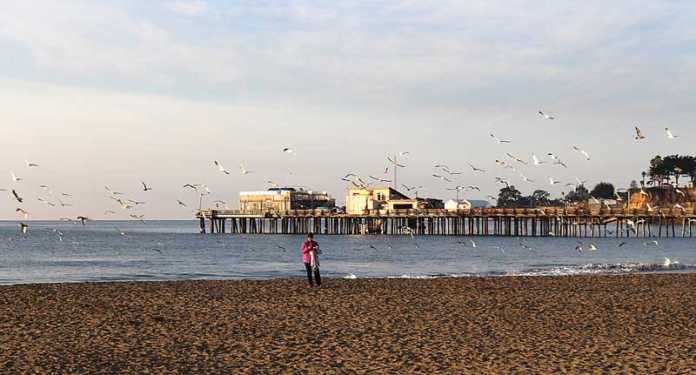WATSONVILLE — As the New Year rushed in on Monday, so did the tides.
The second round of king tides of the season struck Watsonville and the Monterey Bay coast. King tides occur when the Earth, moon and sun are aligned at their closest points, which result in the largest tidal range seen over the course of the year.
The king tides are expected to return today at high tide, estimated at 10:13 a.m., with low tide at 5:09 p.m.
Rachel Kippen, environmental projects coordinator for the City of Watsonville, said as sea levels rise, tidal events such as the king tides push seawater further inland, becoming more destructive as years go by.
The king tides can give residents a glimpse of what daily tides may look like in the future due to sea level rise, she said.
“This is the interesting part about shifting baselines,” Kippen said. “It’s challenging to recognize the amount that has changed year to year, but when you see an event like a king tide, sea level rise is actually visible. One of the most challenging parts of climate change education is that it’s often invisible.”
She added that the best places to view the king tides in Watsonville are at Palm State Beach and the last mile of Watsonville Slough, as well as Elkhorn Slough.
“The coast shoreline is impressive as well on both the high and the low tide, because of how much is brought up on the high and then exposed on the low,” Kippen said.
The last king tide event occurred Dec. 3-5, with two rounds happening every winter, according to Kippen.
Various wildlife groups across the Monterey Bay urged locals to head to the beach to experience the king tides for themselves. There were a few planned events, as well.
At 2 p.m. on New Year’s Day, two wildlife interpreters from Seacliff State Beach led a public walk from New Brighton State Beach to Capitola Beach. The walk was part of America’s State Parks’ movement known as “First Day Hikes,” with more than 80 hikes and other outings planned throughout all 50 states for New Year’s Day.
The strip of beach between New Brighton and Capitola is only accessible during a minus tide such as the low points during the king tide. It gave walkers a unique experience in nature viewing: a number of different tide pools were revealed along the sandy, rocky route — giving people a rare chance to view and document various inhabitants and species.
In addition, remnants of the natural history of Santa Cruz County’s coastline were exposed during the low tides, including many fossils — some millions of years old. One impressive sight only seen during a negative tide is the 5-million-year-old fossil of a whale backbone, embedded permanently in the shoreline.
With rain not on the horizon today, residents are encouraged to document the king tide experience by sharing photos with the California King Tides Project at california.kingtides.net.
But whether Watsonville and Santa Cruz County are in for another year of massive winter storms is still up in the air.
The 2018 Winter Weather Forecast Long Range Prediction, released by the National Oceanic and Atmospheric Association, shows a variable winter season on California’s Central Coast, which means it has an equal chance of a wet or dry season.
Watsonville residents who live in areas prone to flooding are encouraged to pick up pre-filled sandbags at Fire Station #1, 115 Second St., or at Home Depot, 355 South Green Valley Road.
•••
Pajaronian reporter Johanna Miller contributed to this article.














